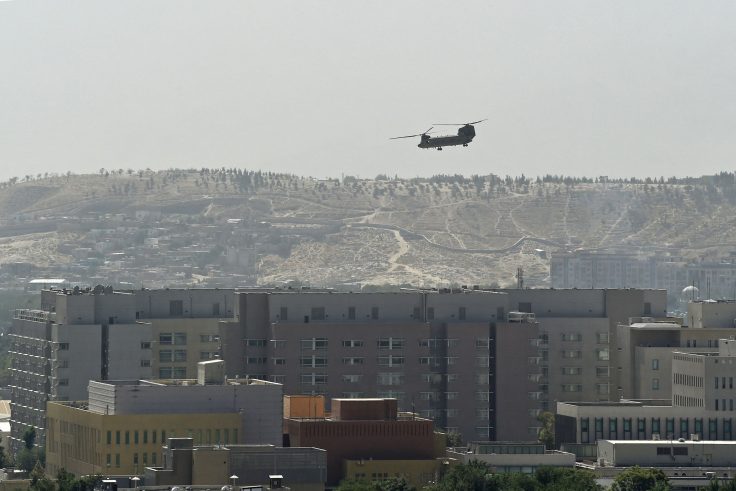The Biden-Harris administration abandoned $57.6 million in American funds, a "significant amount of classified information," and advanced biometric data that enabled the Taliban to hunt down nearly 500 former Afghan officials during its bungled 2021 withdrawal, according to the findings of a three-year long congressional investigation.
The report, published Monday by the House Foreign Affairs Committee, provides previously unknown details about the scope of cash and sensitive information left behind when the United States left Afghanistan in a rushed evacuation that left hundreds of Americans stranded and 13 service members dead.
Because of these security failures, Taliban-controlled Afghanistan is now "a hotbed of terrorist activities." But the Biden-Harris administration has not conducted a single anti-terrorism operation in the country since 2021, suggesting the withdrawal severely hindered the military’s ability to target militants operating in the country.
The sheer scale of the administration’s failure to plan for a catastrophe is the centerpiece of the House committee’s report, which is more than three years in the making. Investigators determined through scores of interviews and subpoenaed documents that, in addition to leaving classified information, millions in cash, and around $7 billion in military hardware, the State Department had "no idea if people being evacuated [from the country] were threats."
In one security lapse documented by the House committee, a U.S. evacuation plane leaving the country included potential terror threats.
"One plane left and as checks got done a few people on the plane popped red and the plane turned around and went back to Kabul," a State Department employee disclosed. "This apparently happened a second time, but the plane was permitted to leave Afghanistan and land in a third-party country."
As the Taliban moved to secure control of Kabul, State Department employees were ordered to begin destroying reams of sensitive documents, according to the report, which determined that "a significant amount of classified information was left to the Taliban."
American officials interviewed by the committee disclosed that "they needed weeks to destroy the materials left behind but were only given one day’s notice by embassy leadership." As a result, when the Taliban closed in, "they still had massive amounts of classified paper documents that they [were] trying to burn," according to one U.S. service member who spoke to the committee.
"Witnesses," the report says, "recalled a large bonfire in the embassy courtyard." Ultimately, "droves of classified information were left behind."
The House committee also attempted to discern the truth about the August 26 Abbey Gate bombing that killed 13 military members.
Throughout the investigation, the committee learned that a "vast amount of information that could have provided answers regarding the Abbey Gate attack was deleted or destroyed in the wake of the bombing, including the destruction or deletion of photos, videos, and more." The Pentagon additionally "demilitarized physical hard drives and servers," preventing investigators from viewing key evidence that could determine how security at the Kabul airport crumbled.
Senior State Department officials in the Kabul embassy also misled leaders back home about the security situation on the ground, going so far as to water down security reports, investigators determined. One military member interviewed by the House committee said the State Department displayed "a lack of understanding of the risk."
The committee also found that Ambassador Ross Wilson, who ran the embassy in Kabul, took a two-week vacation in the last week of July, as Afghanistan was crumbling ahead of the scheduled withdrawal. Wilson was also found to have contracted COVID during the evacuation and faked a negative test so that he could immediately travel from Doha, where evacuees were airlifted, back to America.
Advanced American technology left behind in the country has since "empowered the Taliban to systematically target Afghan allies," including by using their biometric data.
"The Taliban gained access to U.S. military-maintained biometric devices and databases after the withdrawal," according to the report. "The biometric devices in question are enabled to recognize fingerprint, eye scan, and facial information."
Gen. Mark Milley, former chair of the Joint Chiefs of Staff, confirmed in testimony that this technology was used to hunt down and kill U.S. allies "in pretty brutal ways." Milley could not confirm if Americans were also hunted down through similar means.
"I think some were killed, Afghans," he told the committee. "I don’t know about the Americans. I don’t think the Americans were. But I think some of the Afghans were tracked down that worked with us, and I think some of them were killed."
The United Nations estimates that the Taliban has killed or captured around 500 former Afghan officials and security service members since the United States abandoned the country.
Vice President Kamala Harris on Friday attempted to blame former president Donald Trump for the botched withdrawal. "Trump left the Biden-Harris administration with zero plans for an orderly withdrawal," her campaign said in a statement. In the wake of the withdrawal, Harris boasted that she was the "last person in the room" when Biden ordered the pullout.
